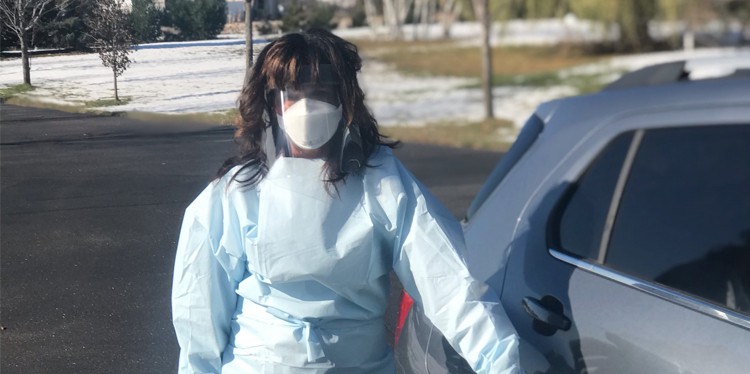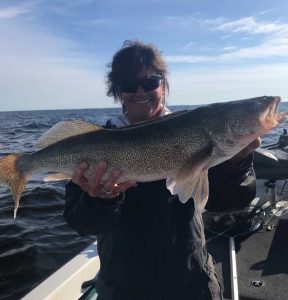The closest to being cared for, is to care for someone else

November is National Home Health Care Month, a time to celebrate the practice of home care and all of the individuals who make it possible, from the patients who inspire us to the caregivers who serve them. One such caregiver is Pam Ruis.
Pam provides health care to our patients wherever they call home. Home health care includes a range of medical, social, assistive, and other services when patients need follow-up care after a hospital visit or require long-term care.
Nursing is Pam’s second career. Growing up, Pam always wanted to be a nurse, but when she received a “D” on her first college biology test, she switched majors. Pam describes herself as a Type A personality and having never received this grade before, she thought that maybe she wasn’t cut out for nursing. Pam went on to get her degree in Education and taught 7th & 8th grade English & History for ten years while living in California.
When Pam and her family returned to Minnesota, she decided to return to school to get her nursing degree. She attended St. Catherine’s University where she received her Bachelors of Nursing and Public Health. Pam spent some time as a student nurse in the HCMC Burn Unit, and after graduation worked as an intermittent nurse there for nearly 15 years.
Prior to joining MVNA (the home health care division of Hennepin Healthcare) in 1999, Pam worked as a nurse in various correctional facilities in Ramsey, Hennepin, and Carver counties. She credits her training in the corrections settings to always being aware of her surroundings and uses this training every day for herself and the patients she sees. Her days start early, often seeing her first patient around 6 am.
Pam was drawn to home health care nursing because it allows her to care for the whole body, emotional, mental, and physical well-being. She offers individualized care to each of her patients. Providing in-home care for patients involves many tasks and responsibilities. This can range from dressing changes, monitoring vital signs, assessing changes in behavior, IV therapy to medication management – Pam has to ensure that her patient understands what she is doing and helps them set goals. “We provide a way for patients to come back home, to be comfortable in their surroundings, and get them back to their lives,” says Pam.
Another important aspect of home health care is education. “Public health is teaching,” says Pam, and she is grateful for her years of being a middle school teacher. She finds unique ways to teach her bi-lingual or illiterate patients, by using characters and images or common items. Pam recalls using a pen to talk to a patient about blood flow and teaching another patient how to count so she would know how much insulin to take. Teaching is a passion for Pam, whether it be for her patients or new employees. “If you have questions, call me for help,” Pam says, “use my experience so you are successful.”
Connecting with her patients, to gain their trust is critical for Pam and is so important for their care. One way Pam connects with her patients is to check out the surroundings they live in, to see if she can find something that interests her patient and start a conversation around that, she uses this practice to build what she calls “a circle of trust.” It opens up the patient to speak freely and feel comfortable with her.
There is no typical day for the home health care nurse, it changes every day based on the patient’s needs. The number of patients seen daily also varies as new admissions to home health care can take up to five hours. Home health care nurses must possess many skills, but for Pam some of the most important are the ability to problem solve, knowledge of the disease process, being aware of safety issues and being able to multi-task. A typical case load may be 22-24 patients and even though each patient is not seen every day, you need to stay ahead of charting and plan for future visits.
COVID-19 has added stress and time for home visits. Upon arrival at each of her patient’s home, Pam must don all of her PPE and she also needs to ensure that patients are also wearing masks for the entire visit. She says she often gets strange looks from people in the neighborhood as she is putting on all of her equipment at her car.
 Patients choose to have home health care for many reasons, but Pam says the most common is that they don’t want to go into a nursing home, “they want to stay home where things are familiar.” Patients typically receive home health care services until their goals are met, medical therapy is completed and pain is managed, but the length of care varies. Pam has cared for some patients for many years, as they have cognitive deficiencies and often need help managing their medications. One of the most rewarding things about being a home health care nurse for Pam is managing a difficult/large wound, getting it completely healed without any infections.
Patients choose to have home health care for many reasons, but Pam says the most common is that they don’t want to go into a nursing home, “they want to stay home where things are familiar.” Patients typically receive home health care services until their goals are met, medical therapy is completed and pain is managed, but the length of care varies. Pam has cared for some patients for many years, as they have cognitive deficiencies and often need help managing their medications. One of the most rewarding things about being a home health care nurse for Pam is managing a difficult/large wound, getting it completely healed without any infections.
In her downtime, Pam is a competitive walleye fisherman. She started competing in tournaments with her dad and enters 15-20 tournaments per year. Cash prizes vary from $3,000-$50,000. The photo shows Pam with one of five walleye caught at a single tournament that put her and her partner in the top five anglers of the tournament. As Pam looks forward to retirement (in the next year or two), she reflects back on her 20+ years as a home health care nurse and says, “I am out here for a reason, to get our patients back to their lives.”

